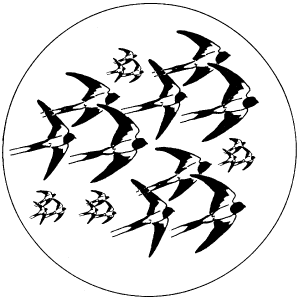 |
 |
"Every group or even every solitairy migrating bird, get its own notice and is put in a database".

Example of data-input:
Species (Soort) - Direction (Richting) - N (N) - "outside" (b)
- Period (K) - Date (data) - Comment (Bijzonderheden)
My countingpoint is on an arbitrary location in the Netherlands, close at my home so I don't have to travel to far on the bike, and on a relative quiet place so you can hear the birds calling. Because of this arbitrary place in the inland, the birds I count are part of the visible broadfront migration.
In autumn most birds migrate in the morning. 50% of birdnumbers (in autumn) migrate in the first 2.5 hours of the day. By using that part of the day for counting you can get a rather good idea of the migration that season. Not all species use the morning to migrate. The best example of daytime-migration are the larger raptors. But also Barn Swallow, House Martin, Swift, Skylark, Jay, Tits, Gulls, are typical birds of which the largest part of migration take place during the late morning and daytime.
In spring average migrating-time is later than in autumn. Perhaps due to having the wind behind one. Thus birdmigration also occurs in spring and can be really spectacular (I have no time for counting that). The way of counting and the dividing of countingperiods during the day in periods is the same as in autumn. Actually, birdmigration is a phenomenon which occurs the whole year but is on most places best visible in autumn.
Just counting on different times of the day gives you an idea of the birdmigration, but when you want to compare one counting with an other counting that season, with countings in other year or at other places, you must have data which you can compare. Because of that, the daylighthours have been split into four parts: early morning; late morning, daytime and evening.
The countings which you find on this website are mostly early morningcountings. One counting exist of 10 periods of 15 minutes counting. Every counting starts 30 minutes before sunrise en stops 2 hours after sunrise. The period of the late morningcountings takes an other two and a half hour after the early morningcountings. The eveningcountings starts two hours before sunset and last until half an hour after sunset. The restperiod of countings during the day is called daytime and here the periods are separated in hours.
|
|||||||||||||||||||||||||||||||||||||||||||||||||||
|
|
|
|
||||||||||||||||||||||||||||||||||||||||||||||||
To find out which direction birds fly, I write down the flight-direction in the "16 different directions". Sometimes you only hear a bird pass by but you can't find it. These birds don't get a direction on paper; they are only "heard". Other birds don't show a very clear direction while migrating. They are soaring or whirling to higher airlayers. These birds get an "indefinite direction"
Birds can pass very close, but also fly high or far away while migrating. Large birds can be seen more than a kilometer away, large groups of geese for example can be detected on several kilometers. When counting with more than one person, people start to look farther and will detect more birds than when you are counting alone and already have problems to detect and counting all the birds flying over your head. Because of that there is the distinction between close flying birds and birds far away. The border of that is a circle around the counting point of 100 meters. Every bird outside that circle (> than 100 meters away) get the notice "outside".Mostly I count alone. This is (can) be a problem. When there is a lot of migration you have to write a lot. For example 20-okt-2001, I counted five hours and I wrote seven pages (A5) full with data. It takes to much time to write birds down and you get crazy of the change writing - looking to birds - write - look - write - etc. For that reason mostly I speak in the observations in a memo-recorder. I use a Sony instead of Philips (because this memo doesn't use power when "pausing".) and work it out later. I write it down on paper and put it in a database later on.
"Every group or even every solitairy migrating bird, get its own notice and is put in a database".

Example of data-input:
Species (Soort) - Direction (Richting) - N (N) - "outside" (b) - Period (K) - Date (data) - Comment (Bijzonderheden)
In the end there will be a database as shown above in which every group of migrating birds is mentioned; species, direction, number, distance, time and date.
The most fun of birdcounting of course is watching the birds pass by ( ....or go to Falsterbo to get your kicks... ) and comparing the numbers with other countings, earlier years or other places. At this moment I put the the totals of the early-morningcountings on the World Wide Web. When I want, it is (thanks to the database) quite easy to produce diagrams of the different species, for example:
- when do they migrate in the season
- At what time in the morning do they pass
- What is their average the flight-direction
- What is the average group-size
- Difference between years and months.
But there are already lots of early morningcountings (also on other locations) I did at the moment (more than 300), and it is going to be more and more next weeks/years. Perhaps in the future-years everyone can make it's own queries of this data on the internet (That can take some time still). For the moment you can find here only daily lists of species and numbers.
1: LWVT = Landelijke Werkgroep Vogeltrek Tellen (which means such as "Dutch Working-group Birdmigration Countings").
